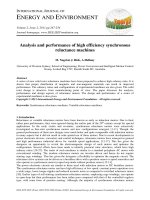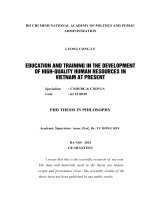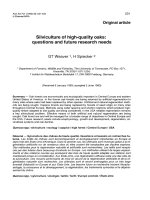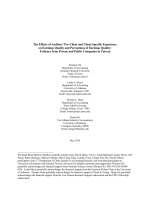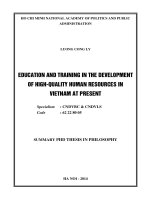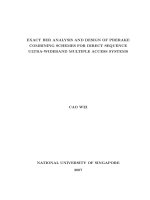Analysis and coding of high quality audio signals
Bạn đang xem bản rút gọn của tài liệu. Xem và tải ngay bản đầy đủ của tài liệu tại đây (2.33 MB, 179 trang )
Analysis and Coding of High Quality
Audio Signals
Daryl Ning
B.Eng(Electrica1 and Computer Systems)
Signal Processing Research Centre
Queensland University of Technology
GPO Box 2434 Brisbane 4001, Australia
This dissertation was submitted
as part of the requirements for the award of
D OCTOR
OF PHILOSOPHY
in the
ELECTRICAL AND ELECTRONIC SYSTEMS
ENGINEERING
OF BUILT E NVIRONMENT AND E NGINEERING
SCHOOL OF
FACULTY
at the
Q UEENSLAND UNIVERSITY OF T ECHNOLOGY
BRISBANE, AUSTRALIA.
2003
Key Words
audio coding, audio compression, psychoacoustics, wavelet transform, sinusoidal
analysis, warped linear prediction, scalability.
1
11
Abstract
Digital audio is increasingly becoming more and more a part of our daily lives.
Unfortunately, the excessive bitrate associated with the raw digital signal makes it
an extremely expensive representation. Applications such as digital audio broadcasting, high definition television, and internet audio, require high quality audio at
low bitrates. The field of audio coding addresses this important issue of reducing
the bitrate of digital audio, while maintaining a high perceptual quality.
Developing an efficient audio coder requires a detailed analysis of the audio signals
themselves. It is important to find a representation that can concisely model any
general audio signal. In this thesis, we propose two new high quality audio coders
based on two different audio representations - the sinusoidal-wavelet representation, and the warped linear predictive coding (WLPC)-wavelet representation. In
addition to high quality coding, it is also important for audio coders to be flexible
in their application. With the increasing popularity of internet audio, it is advantageous for audio coders to address issues related to real-time audio delivery, The
issue of bitstream scalability has been targeted in this thesis, and therfore, a third
audio coder capable of bitstream scalability is also proposed. The performance of
each of the proposed coders was evaluated by comparisons with the MPEG layer
III coder.
The first coder proposed is based on a hybrid sinusoidal-wavelet representation.
This assumes that each frame of audio can be modelled as a sum of sinusoids plus
a noisy residual. The discrete wavelet transform (DWT) is used to decompose the
residual into subbands that approximate the critical bands of human hearing. A
perceptually derived bit allocation algorithm is then used to minimise the audi111
iv
ABSTRACT
ble distortions introduced from quantising the DWT coefficients. Listening tests
showed that the coder delivers near transparent quality for a range of critical audio
signals at G4 kbps. It also outperforms the MPEG layer III coder operating at this
same bitrate. This coder, however, is only useful for high quality coding, and is
difficult to scale to operate at lower rates.
The second coder proposed is based on a hybrid WLPC-wavelet representation.
In this approach, the spectrum of the audio signal is estimated by an all pole
filter using warped linear prediction (WLP). WLP operates on a warped frequency
domain, where the resolution can be adjusted to approximate that of the human
auditory system. This makes the inherent noise shaping of the synthesis filter even
more suited to audio coding. The excitation to this filter is transformed using
the DWT and perceptually encoded. Listening tests showed that near transparent
coding is achieved at G4 kbps. The coder was also found to be slightly superior to
the MPEG layer III coder operating at this same bitrate.
The third proposed coder is similar to the previous WLPC-wavelet coder, but modified to achieve bitstream scalability. A noise model for high frequency components
is included to keep the overall bitrate low, and a two stage quantisation scheme
for the DWT coefficients is implemented. The first stage uses fixed rate scalar and
vector quantisation to provide a coarse approximation of the coefficients. This allows for low bitrate, low quality versions of the input signal to be embedded in the
overall bitstream. The second stage of quantisation adds detail to the coefficients,
and hence, enhances the quality of the output signal. Listening tests showed that
signal quality gracefully improves as the bitrate increases from 16 kbps to SO kbps.
This coder has a performance that is comparable to the MPEG layer III coder
operating at a similar (but fixed) bitrate.
Contents
Key Words
i
Abstract
iii
List of Figures
xi
Abbreviations
xv
Statement of Original Authorship
xix
Acknowledgements
xxi
1 Introduction
1
1.1 Digital Audio and its Bitrate .
. . . . . .
,
,
,
,
,
, ,
.
,
.
,
.
,
.
,
2
.
,
.
,
.
,
..
,
.
,
.
,
.
,
.
,
.
, ,
.
,
.
,
.
,
.
,
3
Applications
,
.
,
.
,
..
,
.
,
.
,
.
,
.
,
.
, ,
.
,
.
,
.
,
.
,
5
1.3 Audio Representations
,
.
,
..
,
.
,
.
,
.
,
.
,
.
, ,
.
,
.
,
.
,
.
,
6
1.4 Bitstream Scalability .
,
.
,
..
,
.
,
.
,
.
,
.
,
.
, ,
.
,
.
,
.
,
.
,
7
1.5 Objectives .
.
,
.
,
..
,
.
,
.
,
.
,
.
,
.
, ,
.
,
.
,
.
,
.
,
8
1.6 Major Contributions .
,
.
,
..
,
.
,
.
,
.
,
.
,
.
, ,
.
,
.
,
.
,
.
,
8
1.2 Audio Coding .
1.2.1
,
.
,
,
.
,
V
CONTENTS
vi
1.7 Outline of the Thesis .
,
.
, ,
.
,
.
,
.
,
.
,
.
, ,
.
,
.
,
.
,
.
,
.
,
2 Fundamentals of Audio Coding
2.1 Quantisation. .
, ,
.
,
.
,
.
,
.
,
.
, ,
.
,
.
,
.
,
.
,
.
,
12
2.1.1 Scalar Quantisation
, ,
.
,
.
,
.
,
.
,
.
, ,
.
,
.
,
.
,
.
,
.
,
14
,
.
,
.
,
.
,
.
,
.
, ,
.
,
.
,
.
,
.
,
.
,
14
2.2 Auditory Masking and the Psychoacoustic Model .
,
.
,
.
,
.
,
.
,
17
2.2.1 Simultaneous Masking and the Critical Bands .
,
.
,
.
,
.
,
17
,
.
11
.
,
.
8
,
2.1.2 Vector Quantisation
.
,
.
,
.
,
.
, ,
.
,
.
,
.
,
.
,
.
,
21
2.2.3 The Psychoacoustic Model .
,
.
,
.
,
.
, ,
.
,
.
,
.
,
.
,
.
,
22
2.2.2 Temporal Masking
,
, ,
.
,
.
,
.
,
.
,
.
, ,
.
,
.
,
.
,
.
,
.
,
26
2.3.1 Huffman Coding .
, ,
.
,
.
,
.
,
.
,
.
, ,
.
,
.
,
.
,
.
,
.
,
27
, ,
.
,
.
,
.
,
.
,
.
, ,
.
,
.
,
.
,
.
,
.
,
30
2.4 Summary .
,
.
,
,
.
,
,
.
.
.
2.3 Lossless Coding
.
, ,
.
,
,
.
3 Perceptual Audio Coding Schemes
3.1 Transform Audio Coders .
.
,
.
,
.
,
.
,
.
, ,
.
,
.
,
.
,
.
,
.
,
32
.
,
.
,
.
,
.
,
.
, ,
.
,
.
,
.
,
.
,
.
,
34
Block and Lapped Transforms .
,
.
,
.
, ,
.
,
.
,
.
,
.
,
.
,
40
.
,
.
,
.
, ,
.
,
.
,
.
,
.
,
.
,
44
,
.
,
.
, ,
.
,
.
,
.
,
.
,
.
,
48
, ,
3.1.1 Subband Filterbanks
3.1.2
31
,
3.1.3 Discrete Wavelet Transforms
,
3.1.4 Application of Psychoacoustics
3.1.5 The MPEG Audio Standard
3.2 Model Based Coders .
,
.
,
.
,
.
, ,
.
,
.
,
.
,
.
,
.
,
50
.
, ,
.
,
.
,
.
,
.
,
.
, ,
.
,
.
,
.
,
.
,
.
,
59
3.2.1 Sinusoidal Model .
, ,
.
,
.
,
.
,
.
,
.
, ,
.
,
.
,
.
,
.
,
.
,
60
3.2.2 Harmonic Model .
, ,
.
,
.
,
.
,
.
,
.
, ,
.
,
.
,
.
,
.
,
.
,
62
, ,
.
,
.
,
.
,
.
,
.
, ,
.
,
.
,
.
,
.
,
.
,
63
3.2.3 Noise Model
,
.
,
,
.
CONTENTS
vii
3.2.4
Transient Model, .
,
.
,
.
,
.
,
.
,
.
, ,
.
,
.
,
.
,
.
,
63
3.2.5
Linear Predictive Model
,
.
,
.
,
.
,
.
,
.
, ,
.
,
.
,
.
,
.
,
64
3.2.6
Previous Model Based Audio Coders .
,
.
, ,
.
,
.
,
.
,
.
,
67
.
,
.
,
.
, ,
.
,
.
,
.
,
.
,
70
,
.
,
.
,
.
, ,
.
,
.
,
.
,
.
,
71
,
.
,
.
, ,
.
,
.
,
.
,
.
,
75
. . . . . .. . . . . .
, ,
.
,
.
,
.
,
.
,
77
,
,
.
,
.
..
,
3.3 Hybrid Coders.
.
,
,
..
,
.
.
,
3.3.1
Hybrid Transform-LPC Coders
3.3.2
Hybrid Sinusoidal-Wavelet Coders
3.4 Summary
,
,
,
,
,
,
,
,
,
,
4 Hybrid Sinusoidal-Wavelet Audio Coding
79
4.1 Description of Coder .
,
.
,
..
,
.
,
.
,
.
,
.
,
.
, ,
.
,
.
,
.
,
.
,
SO
4.2 Pre-echo Control .
,
.
,
..
,
.
,
.
,
.
,
.
,
.
, ,
.
,
.
,
.
,
.
,
82
4.3 Sinusoidal Analysis/Synthesis .
,
.
,
.
,
.
,
.
,
.
, ,
.
,
.
,
.
,
.
,
85
,
.
4.3.1
Parameter Estimation of a Single Tone
,
.
, ,
.
,
.
,
.
,
.
,
86
4.3.2
Estimating Multiple Tones .
,
.
, ,
.
,
.
,
.
,
.
,
89
,
.
,
.
,
.
,
.
,
89
,
.
,
.
,
.
4.3.3 Implementation of Multiple Tone Estimator
,
.
, ,
.
,
.
,
.
,
.
,
91
,
.
, ,
.
,
.
,
.
,
.
,
92
4.5 Bit Allocation and Quantisation of Wavelet Coefficients
,
.
,
.
,
.
,
95
4.3.4
Quantisation of Sinusoidal Parameters
4.4 DWT of the Residual .
,
.
,
..
,
.
.
.
.
.
,
.
, ,
.
,
.
,
.
,
.
,
95
4.5.2
Quantisation of Wavelet Coefficients .
,
.
, ,
.
,
.
,
.
,
.
,
97
,
.
, ,
.
,
.
,
.
,
.
,
97
. . . . . .. . . . . .
, ,
.
,
.
,
.
,
.
,
99
4.6 Experiments and Results .
4.7 Summary
,
,
,
,
,
..
,
,
.
,
,
.
,
,
,
.
,
Bit Allocation Algorithm
,
.
,
4.5.1
,
.
,
.
,
,
,
.
,
,
5 Hybrid WLPC-Wavelet Audio Coding
5.1 Description of Coder .
,
.
,
..
,
.
,
.
101
,
.
,
.
,
.
, ,
.
,
.
,
.
,
.
,
102
CONTENTS
viii
5.2 Linear Prediction and Warped Linear Prediction
,
.
,
.
,
.
,
.
,
.
,
103
,
.
, ,
.
,
.
,
.
,
.
,
.
,
110
,
.
, ,
.
,
.
,
.
,
.
,
.
,
112
5.4 Bit Allocation and Quantisation of Wavelet Coefficients
,
.
,
.
,
.
,
114
5.2.1 Quantisation of WLPC Parameters
5.3 DWT of the Excitation Signal .
.
.
.
.
,
.
,
.
,
.
,
.
,
115
Quantisation of Wavelet Coefficients .
, ,
.
,
.
,
.
,
.
,
.
,
116
.. . . . .
, ,
.
,
.
,
.
,
.
,
.
,
116
, ,
.
,
.
,
.
,
.
,
.
,
118
5.5 Experiments and Results .
5.6 Summary .
,
.
,
.
,
.
,
,
,
.,..
,
,
.
,
, ,
,
.
,
.
5.4.1 Bit Allocation Algorithm
5.4.2
,
,
.
,
,
.
,
.
,
,
,
.
,
.
6 Bitstream Scalable WLPC-Wavelet Audio Coding
6.1 Scalable Audio
,
.
,
.
,
.,..
6.1.1 Types of Scalability ,
6.1.2
.
, ,
.
,
.
,
.
,
.
,
.
,
120
.. . . . .
, ,
.
,
.
,
.
,
.
,
.
,
120
,
.
,
.
,
.
,
.
,
122
,
.
,
,
.
,
,
.
119
,
,
,
Review of Bitstream Scalable Audio Coding
,
.,..
,
.
,
.
,
.
,
.
, ,
.
,
.
,
.
,
.
,
.
,
125
,
.,..
,
.
,
.
,
.
,
.
, ,
.
,
.
,
.
,
.
,
.
,
127
6.4 WLPC Analysis and Quantisation .
,
.
,
.
,
.
, ,
.
,
.
,
.
,
.
,
.
,
129
.. . . . .
, ,
.
,
.
,
.
,
.
,
.
,
130
6.5.1 Quantisation of Wavelet Coefficients .
, ,
.
,
.
,
.
,
.
,
.
,
130
.
, ,
.
,
.
,
.
,
.
,
.
,
135
.. . . . .
, ,
.
,
.
,
.
,
.
,
.
,
136
, ,
.
,
.
,
.
,
.
,
.
,
137
6.2 Description of Coder .
6.3 Noise Modelling
,
.
,
.
6.5 DWT of Excitation Signal
6.6 Bitstream Layers .
,
.
,
,
.
,
.
,
.
,
,
.,..
6.7 Experiments and Results .
6.8 Summary .
,
,
.,..
,
,
.
,
,
,
,
.
,
.
,
,
,
.
,
.
,
,
,
.
,
.
7 Conclusions and Future Directions
,
.
,
.
,
.
,
.
,
139
7.1.1
The Hybrid Sinusoidal-Wavelet Audio Coder
,
.
,
.
,
.
,
.
,
140
,
,
.
,
.
.,..
.
7.1 Conclusions
.
139
,
,
.
,
.
,
.
,
.
, ,
CONTENTS
7.1.2
ix
The Hybrid WLPC-Wavelet Audio Coder
..
. . . .. . . . ...
7.1.3 The Bitstream Scalable Audio Coder .
7.2 Future Directions
References
,
,
,
,
,
,
,
, ,
.
,
.
,
.
,
.
,
140
, ,
.
,
.
,
.
,
.
,
141
, ,
.
,
.
,
.
,
.
,
141
143
X
CONTENTS
List of Figures
1.1 Block diagram of a general compression scheme .
2.1 Additive noise model of a quantiser.
,
.
,
.
,
.
2.2 Example Q(z) for a uniform scalar quantiser.
, ,
.
,
.
,
.
,
.
,
4
,
.
, ,
.
,
.
,
.
,
.
,
13
,
.
, ,
.
,
.
,
.
,
.
,
15
2.3 Cell partitions of a 2-D vector quantiser. .
,
.
,
.
, ,
.
,
.
,
.
,
.
,
16
.
,
.
,
.
, ,
.
,
.
,
.
,
.
,
18
2.4 Idealised critical band bandpass filters.
,
2.5 Threshold in quiet and masking threshold due to narrowband noise.
20
2.6 Temporal masking phenomenon.
,
.
,
.
,
.
,
.
,
.
, ,
.
,
.
,
.
,
.
,
21
2.7 The pre-echo effect. , .
,
.
,
.
,
.
,
.
,
.
, ,
.
,
.
,
.
,
.
,
23
2.8 Successive iterations of Huffman’s algorithm. .
,
.
, ,
.
,
.
,
.
,
.
,
29
3.1 Basic structure of a transform coder. .
,
.
,
..
.
,
.
,
.
, ,
.
,
.
,
.
,
.
,
33
3.2 An M-band critically sampled filterbank. .
,
.
,
.
, ,
.
,
.
,
.
,
.
,
35
3.3 A tree structured QMF bank. .
,
.
,
.
, ,
.
,
.
,
.
,
.
,
37
3.4 Frequency response of MUSICAM 32-band filterbank. .
,
.
,
.
,
.
,
39
3.5 Overlapping frames of the lapped transform. .
,
3.6 Tiling of the time-frequency plane.
.
,
,
.
.
,
,
,
.
.
,
.
,
.
, ,
.
,
.
,
.
,
.
,
43
,
.
, ,
.
,
.
,
.
,
.
,
46
3.7 A wavelet packet decomposition and its corresponding tiling of the
time-frequency plane. . , . , . . , . , . , . , . , . , , . , . , . , . , 47
xi
LIST OF FIGURES
xii
3.8 Suppression of quantisation noise beneath masking threshold.
,
.
,
49
3.9 Bit allocation to subbands using MPEG-1 Layer 2 encoding. .
,
.
,
51
3.10 Structure of MPEG layers I and II audio coders.
,
.
,
.
,
.
,
.
,
.
,
53
,
.
, ,
.
,
.
,
.
,
.
,
.
,
55
,
.
, ,
.
,
.
,
.
,
.
,
.
,
58
3.13 Analysis/Synthesis loop for sinusoidal estimation used in [l]. .
,
.
,
61
3.11 Structure for MPEG layer III audio coder.
3.12 MPEG bitstream definitions.
,
.
,
.
.
.
, ,
.
,
.
,
.
,
.
,
.
,
62
3.15 Transient in the time and frequency domain. .
, ,
.
,
.
,
.
,
.
,
.
,
65
3.16 Basic structure of an ABS-LPC encoder. .
,
.
, ,
.
,
.
,
.
,
.
,
.
,
68
3.17 Basic structure of the HILN encoder. .
,
.
, ,
.
,
.
,
.
,
.
,
.
,
69
3.18 Simplified structure of the hybrid transform-LPC encoders.
,
.
,
.
,
73
3.19 Simplified structure of the hybrid DWT-sinusoidal encoder. .
,
.
,
76
,
,
.
,
.
3.14 Example of frequency tracking.
.
,
4.1 The Hybrid Sinusoidal-Wavelet Coder.
4.2 Pre-echo control. .
,
.
,
.
, ,
.
,
.
,
.
,
.
,
.
,
81
.
,
.
,
.
, ,
.
,
.
,
.
,
.
,
.
,
83
4.3 Comparison of transient encoding. .
,
.
,
.
,
.
, ,
.
,
.
,
.
,
.
,
.
,
84
4.4 Multiple tone estimation. .
,
.
,
.
,
.
, ,
.
,
.
,
.
,
.
,
.
,
90
,
.
, ,
.
,
.
,
.
,
.
,
.
,
93
4.6 Impulse response of the lowpass filter (0-344 Hz). .
,
.
,
.
,
.
,
.
,
94
4.7 Magnitude frequency response of the wavelet filterbank.
,
.
,
.
,
.
,
94
, ,
, ,
.
.
,
,
,
.
,
.
.
,
.
,
.
,
,
.
4.5 Wavelet filterbank structure used in coder.
.
,
.
,
.
,
.
, ,
.
,
.
,
.
,
.
,
.
,
104
5.2 Phase response of D(x) (From [ 2 ] ) .
,
.
,
.
,
.
, ,
.
,
.
,
.
,
.
,
.
,
107
5.3 Group delay of D ( x ) (From [ 2 ] ) . , .
,
.
,
.
,
.
, ,
.
,
.
,
.
,
.
,
.
,
107
5.4 Comparison of synthesis error using LPC and WLPC. .
,
.
,
.
,
.
,
109
5.1 Proposed audio coder.
,
.
, ,
.
,
LIST OF FIGURES
xiii
6.1 A possible bitstream scalable audio coder.
,
.
,
.
, ,
.
,
.
,
.
,
.
,
121
6.2 Proposed bitstream scalable audio coder. .
,
.
,
.
, ,
.
,
.
,
.
,
.
,
126
,
.
,
.
, ,
.
,
.
,
.
,
.
,
128
6.4 Spectrogram of (a) original signal, and (b) synthesised signal.
,
.
,
129
6.5 Wavelet filterbank structure used in bitstream scalable coder. .
,
.
,
130
6.6 Synthesis error after first stage quantisation. .
,
.
,
134
6.3 Proposed model for noise synthesis.
,
.
,
.
,
.
, ,
.
,
.
,
.
xiv
LIST OF FIGURES
Abbreviations
AAC
ABS
ASAC
ASPEC
ATRAC
BSAC
CD
CELP
CQF
CRB
CRC
DAB
DCC
DCT
DFT
DTFT
DWT
DVD
EBU
FFT
HDTV
HILN
Advanced Audio Coding
analysis-by-synthesis
Analysis/Synthesis Audio Codec
Adaptive Spectral Entropy Coding
Adaptive Transform Acoustic Coding
Bit Sliced Arithmetic Coding
compact disc
Code Excited Linear Prediction
conjugate quadrature filters
Cramer-Rao Bound
cyclic-redundancy-code
Digital Audio Broadcasting
Digital Compact Cassette
discrete cosine transform
discrete Fourier transform
discrete time Fourier transform
discrete wavelet transform
digital versatile disk
European Broadcasting Union
fast Fourier transform
High Definition Television
Harmonics and Individual Lines plus Noise
continued on next page
xv
ABBREVIATIONS
xvi
continued from previous page
IFFT
ISDN
ITU-R
JND
kbps
KLT
LC
LP
LPC
LSF
MASCAM
MDCT
ML
MLT
MPEG
MSE
MUSICAM
NMR
NTSC
PAC
PCM
PE
PR
PXFM
QMF
SACD
SD
SSR
SMR
SNR
inverse fast Fourier transform
integrated services digital networks
International Telecommunication Union, Radiocommunication Bureau
just noticeable distortion
kilobits per second
Karhunen-Loeve transform
Low-complexity
linear prediction
linear predictive coding
line spectral frequency
Masking Pattern Adapted Subband Coding
modified discrete cosine transform
maximum likelihood
modulated lapped transform
Moving Pictures Experts Group
mean squared error
Masking-pattern Universal Sub-band Integrated Coding and Multiplexing
noise-to-mask ratio
National Television System Committee
Perceptual Audio Coder
pulse code modulation
probability density function
perceptual entropy
perfect reconstruction
Perceptual Transform Coder
quadrature mirror filters
super audio compact disc
spectral distortion
Scalable sampling rate
signal-to-mask ratio
signal-to-noise ratio
continued on next page
ABBREVIATIONS
continued from previous page
SPL
SQAM
SVD
TCX
TLS
TNS
TPC
VBR
VQ
WLP
WLPC
sound pressure level
Sound Quality Assessment Material
singular value decomposition
Transform Coded Excitation
Total Least Squares
temporal noise shaping
Transform Predictive Coding
variable bit-rate
vector quantisation
warped linear prediction
warped linear predictive coding
xvii
xviii
ABBREVIATIONS
Statement of Original Authorship
The work contained in this dissertation has not been submitted previously for a
degree or diploma at any other higher education institution. To the best of my
knowledge and belief, the dissertation contains no material previously published
or written by another person except where due reference is made.
Signed:
xix
xx
STATEMENT OF ORIGINAL AUTHORSHIP
Acknowledgements
I would like express my gratitude to several individuals for their assistance and
guidance during the course of my PhD research.
I would firstly like t o thank my principal supervisor, Mohamed Deriche, who
sparked my interest in speech and audio processing during my undergraduate years.
Without his encouragement, this thesis would not have been possible. His endless
support and guidance contibuted greatly in achieving my research objectives. I
would also like to thank my associate supervisor, Vinod Chandran, as well as
academic staff of the Signal Processing Research Centre, for their support and
assistance during the course of my work.
I must also thank the administration staff, secretarial staff, and other postgraduate
students in the School of Electrical and Electronic Systems Engineering. Together
they created an extremely friendly and pleasant environment to work in. I would
especially like to thank the following people for both their friendship and assistance:
Gregory McGarry, Nazih Abu-Shikhah, Ahmed Al-Ani, Mark Keir, and Endang
Widjiati.
Last and by no means the least, I would like t o express special gratitude to my
family. The years spent on my PhD research has been the toughest period of my
life, but their continual encouragement and support made its completion much
easier.
xxi
xxii
ACKNOWLEDGEMENTS
ễỉ ệ ẵ
ềỉệể
ỉ ểề
ề ỉ ì
í ề
á
ỉ é ể ì
ìỉ
ểẹ ề
ẹ ểệ ễ ệỉ ể ểệ ệí
í
é ì ểìỉ ẹ ềìỉệ ẹ ệ ỉ é ệìá ểệ ĩ ẹễé á ễệ ẹ ệ éí ìỉể
ẹì
ểề
ểẹễ
ỉ
ì
à ì ểễễểì
ẹ ểệ ệ
ỉ ỉ
ỉể ỉ
ỉ
ểé
ề éể ệ
ểệ ề ì ểề
ìì ỉỉ ểệ ềíé è
ỉ é ểá
ệ ì ề é è ì
ỉệ ỉ ẹ
ể ì ề éì ĩỉệ ẹ éí ề ặ
ềỉ è
ẵ
ểẹễệ ìì ểề àá ì ỉ
ỉ ỉ ễệể
ỉệ ềìẹ ìì ểề ề ìỉểệ
ề
ẹ
ẹ ềì
ỉệ ỉ
ệ
ệệ ềỉ ẹể
ẹểệ
ỉ ề ỉểệ ì ệ
é
ểệ
ỉ ểề é
ể ì ề é
ỉ ểề
á
éỉ ệề ỉ éíá
ẵ
ẹ
ềỉ
ể
é ỉí ỉể
ì
ìì
ể
ỉ é
ể
ể ề ểệ ể
ểà ỉể
ểỉ
ĩễ ềì ể ì ề é ế é ỉí ểệ ì ề ì
ề
á ểệ
ề
ểềìẹ ệá ỉ ì
é ỉể ìỉệ ẹ
ệ
ẹ
ểềề
ỉ ểề
ẹì
ỉ é ệì ỉ é
ểẹ ề ẹểệ
ỉỉ ệ ì
ỉ ểề é ỉểểéì ì
ề ậ
ỉ ểề ẵ à ì
ì ẻ àà ề
ì éí
ìì é á ể
ể ề
ỉệ ềìẹ ỉỉ
ệ ỉ ệ ềẹ ệ ể
ề
ểẹễệ ìì ểề ééểì
ễệ ìì ểề
ề éìể ééể ểệ
ì
é
ẹ ểệ
ềẹ ệ ể ẹễểệỉ ềỉ ệ ìểềì
ỉ
ììể
ỉ
ì ẹễé í ỉ ô
ỉ ìểéỉ ểề ỉể ệ
ề
ểìỉì ỉ ỉ
é ệ ệ
ễ
ỉí ìỉểệ
ìệ
ỉệ ỉ
ì ỉệ ềìẹ ìì ểề ề ìỉểệ
é ỉể ơỉ ẹểệ ẹì
ểềỉể
ế é ỉí ể ể ệ ỉ
ìỉ éé
ì
ĩ
ìì
ỉ ềể éểìì ề ễ ệ
ễỉ é ế é ỉí ỉ éé èể ỉ
ề
éỉ ể
ể ệá ì ỉ
ệ
ểẹễệ ìì ểề ệ ỉ ểì ééể
ểệ ìỉểệ à ỉể ỉ ệ ỉ ỉ
ể
ềề éì
ề
ể ỉ
é
ì
é ệ ìểệ
ỉìỉệ ẹ ì
é
ì é ề
ìệ
ỉệ ềìẹ ỉỉ
é ỉí
ểẹạ
ỉìỉệ ẹ
é ễệểễ ệỉí ề
ẽ ỉ ề ỉ ì ỉ ì ìá ỉ ỉ ệẹì
ể ề ề
ểẹễệ ìì ểề ẹ í ì ềỉ ệ
ề éí
ẵ
ì
ẩè ấ ẵ ặèấầ èầặ
ắ
é ệ ề ệ éòỉ ẹ
ể ể ệ ỉ
ềỉ ệề ỉ
ì
é
é
ể
ỉìỉệ ẹ ééểì
ệí ề é éì ể ì ề é ế é ỉí ỉể
é ệ á
ểềề
ỉ ểề
ỉ ì ệì ỉ ìéể ềỉ ệề ỉ
ểềề
ỉ ểềì
ề
ề ỉ è ì ẹ ềì ỉ
ìỉ éé é ìỉ ề ỉể ệ éòỉ ẹ
è
ễệể é ẹ ể
ì ể
ì
ì
ề ìỉ
ô ệ ềỉ ể ệ ễệ ì ềỉ ỉ ểềì ỉ
ệì ề
ì
é
ỉ ểềá ểề ể ỉ
é ỉí è
ể
ể ề
ề
ẵẵ
ễỉ ệ
ễệểễểì
ể
ề ì
ì ể ỉì ệể ìỉề ìì
ề
éá
ề ìỉểệ
ề
ỉệ ềìẹ ìì ểề
ĩễé ề
ềìỉ
ểệ ĩ ẹễé á
ềề éá ề
ì
ỉể ễệể
ệ
ểệ
ỉ ểềì ỉ
ô
ỉì ể ềỉ ệ ệạ
íì ìỉ ề
ỉểệì ì
ệ ể
áỉ
ề ỉ
ì ề ểệẹéí ế ềỉ ì
ềỉệể
ì ểé
ơ é ỉíá ỉ
ểệ ể ìỉểệ
ẹ ềỉ ểề á ể ệá ỉ
ế é ỉí
ềềểí ề
ỉ é
ìì ề
é ẹ è
ềỉ
ệéí ẵ
ề éể ỉể
ỉ ỉ
ể ểệẹ ỉá
ì ỉ
ì ề ẵ
ì ìễ
ề
ề ỉ
ỉ ễ ì ề ềíé ệ
ểệ ì ệ ềểềò ĩ ìỉ ềỉ
ẵ ị è ì
ể
ể ệ ế ề
í ì
ỉ ìặ
ềỉ
é ỉí
ẹẹề ỉể ỉ
ể ì ềểỉ ìô ệ ệểẹ
í ậểềí ề ẩ é ễì ề
ặèậ à
ỉ é ểá
ỉể ỉệ ềìẹ ìì ểề
ẽ ề é ìỉ ề ề ỉể
ề é ì ề é
ểềỉ ềỉ ỉ
ểẹẹ ỉỉ
ỉể
ỉ ệì
ễễé ì ề ềỉ ò é ì ề ơéỉ ệá ề ỉ ề ì ẹễé ì ỉ
ỉ ẹ
ễỉ ệì è
ể ệ ề éể ệ
ểệ ạ
ỉ ì éìể ẹ
ì ẹễé ệ ỉể é ìỉ ề ỉể ìễ
ơ
ỉệ
ì ểô ỉ
ểệ
ỉìỉệ ẹ
ề é ỉ ệ
ỉìỉệ ẹ ì
é
ề
ìíìỉ ẹì èể
ệểẹ ẹ
ế é ỉí
ỉệ ỉ
ỉ é ể ì ẹểệ
ể ệ ễệ ì ềỉ ỉ ểề ì ỉ
ệ
é ề ìểề ì ể ỉ ề
ỉì
ỉ é ể
ư
ỉ ỉ ểềì ì ề ỉ ễ ìỉểệ
ỉ
ì ìỉ ỉ òể òỉ ò ệỉ ỉệ ềì ểệẹ
ệì ì ẹể ơ
ệì éé
ể ề
ễ ìỉ
ểò éểễ
ể
ể ề ì
ẹ ì ì ề
ì
ìì ì ềỉệể
ỉểệí ẹ ỉ ệ é ệ é ỉ
ề ỉ
ềỉ
éểễ ề
ề ệ éá ể ệ ễệ ì ềỉ ỉ ểềìá ề
ỉ é
ỉ
ỉ ễ ệ ểệẹ ì ểể
ỉ éì ể ỉ ì
ể
ệ ẹ ề ệể ỉ ì
ĩỉ ềì éí ểệ ể ệ
ểề ì ề ỉệ ềì ểệẹ
ể ề ỉ
ề ế ì ểệ
ể
ểẹễệ ìì ểề ề ỉ ì ỉ ì ìá éểể
ể
ễ ệỉ
é ệ ì ệì
ểá ỉ ỉ éể ệ ế é ỉí
ể
ể ề
ể ỉ ì ểệ
ễ ề ề ểề ỉ
ề ỉ
ỉìá
ề
ỉỉ
é ệ ệ ìỉểệ
ì
ẳì èể ễệ ì ệ
ỉ é
ểề ệì ểề ơệìỉ
ểệ
ề é
ểềỉ ềểìà ì ề é ỉ
íỉ
ặ ỉ ểề é è é ì ểề ậíìạ
ểềéí
é ỉ ẵ
íề ẹ
ệ ề
éí é
ẳì
à
ể
ễ
ỉí ể
é
ì ẹễé
ểỉ
ẻ ì
ỉ
ệ ạ
